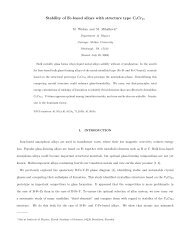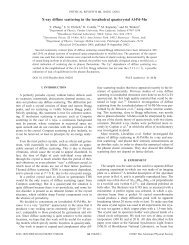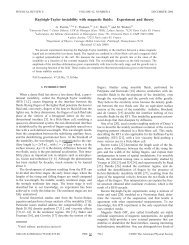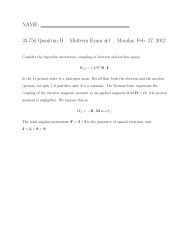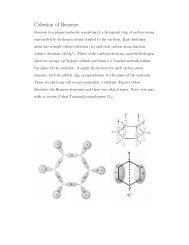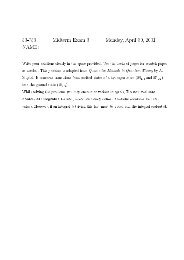Author's personal copy - It works! - Carnegie Mellon University
Author's personal copy - It works! - Carnegie Mellon University
Author's personal copy - It works! - Carnegie Mellon University
You also want an ePaper? Increase the reach of your titles
YUMPU automatically turns print PDFs into web optimized ePapers that Google loves.
<strong>Author's</strong> <strong>personal</strong> <strong>copy</strong>Computer Physics Communications 183 (2012) 1422–1426Contents lists available at SciVerse ScienceDirectComputer Physics Communicationswww.elsevier.com/locate/cpcVASP on a GPU: Application to exact-exchange calculations of the stabilityof elemental boronM. Hutchinson, M. Widom ∗Department of Physics, <strong>Carnegie</strong> <strong>Mellon</strong> <strong>University</strong>, Pittsburgh, PA 15213, United Statesarticle info abstractArticle history:Received 1 December 2011Accepted 14 February 2012Availableonline20February2012Keywords:Hybrid functionalExact exchangeBoronGeneral purpose graphical processing units (GPU’s) offer high processing speeds for certain classes ofhighly parallelizable computations, such as matrix operations and Fourier transforms, that lie at theheart of first-principles electronic structure calculations. Inclusion of exact-exchange increases the costof density functional theory by orders of magnitude, motivating the use of GPU’s. Porting the widelyused electronic density functional code VASP to run on a GPU results in a 5–20 fold performance boost ofexact-exchange compared with a traditional CPU. We analyze performance bottlenecks and discuss classesof problems that will benefit from the GPU. As an illustration of the capabilities of this implementation,we calculate the lattice stability α- andβ-rhombohedral boron structures utilizing exact-exchange. Ourresults confirm the energetic preference for symmetry-breaking partial occupation of the β-rhombohedralstructure at low temperatures, but does not resolve the stability of α relative to β.© 2012 Elsevier B.V. All rights reserved.1. IntroductionFirst principles quantum mechanical calculations of total energyare among the most pervasive and demanding applications of supercomputers.The problem is an interacting many-body problemwhose wavefunction depends on the coordinates of N e electrons.The computational complexity grows exponentially with the numberof electrons [1], thus severely limiting the number of atomsthat can be treated. Elemental boron, for example, with its highlycomplex crystal structure containing approximately 107 atoms, lieswell beyond the limits of exact energy calculation.Replacing the many-body problem with N e coupled single electronproblems reduces the exponential dependence to a polynomial,at the cost of introducing approximations. For example, bothHartree–Fock (HF) and electronic density functional theory (DFT)are formally O(Ne 4 ) in complexity [2]. However, further approximationscan additionally reduce the dependence on N e . Indeed,O(N e ) methods are possible in principle provided the problem issufficiently local [3]. In practice, for the physics problems to bediscussed below (utilizing the plane-wave-based code VASP), thecomplexity of HF-type hybrid functionals [4] is O(Ne 3 log N e) andfor DFT [5] it is O(Ne 2 log N e). The benefit of HF-type calculationis the exact treatment of electron exchange interactions, while thenet cost amounts to orders of magnitude in run time.While the run time could possibly be reduced by runningon a faster computer, actual frequencies of computer chips have*Corresponding author.E-mail address: widom@andrew.cmu.edu (M. Widom).held rather constant in recent years. Instead of running at higherfrequencies, the trend has been to increase computer powerthrough parallelization, using multi-core chips, multi-chip nodes,and multi-node computer systems. Recently massively parallel processingbecame available for low-cost computer systems throughthe introduction of general purpose graphical processing units(GPU). These systems can contain hundreds of cores, with a lowcost and low power consumption per core. <strong>It</strong> is thus of highinterest to evaluate the suitability of GPU systems for practicalelectronic structure calculations. The fast Fourier transformation(which is an important VASP bottleneck) has been ported to theGPU [6]. Here we address the hybrid HF-DFT functionals that includeexact-exchange.Below, we first summarize the physics problem to be addressed,then describe our implementation of VASP on a GPU system, andfinally we apply it to study the energies of competing boron structures.Our key results are: 1) Exact-exchange calculations confirmthat the symmetric β structure is energetically unfavorable relativeto α, but its energy can be reduced through symmetry breakingpartial site occupancy. 2) The GPU system outperforms the CPU,with speedups reaching a factor of 20 in computationally demandingcases.2. Elemental boronBoronisofpracticalinterestbecauseofitslightweight,highstrength and semiconducting properties. <strong>It</strong> is also intrinsically interestingowing to its many competing complex structures, notablythe α- and β-rhombohedral structures characterized by differingarrangements of icosahedral clusters, as illustrated in Fig. 1.0010-4655/$ – see front matter © 2012 Elsevier B.V. All rights reserved.doi:10.1016/j.cpc.2012.02.017
<strong>Author's</strong> <strong>personal</strong> <strong>copy</strong>M. Hutchinson, M. Widom / Computer Physics Communications 183 (2012) 1422–1426 1423Fig. 1. (Color online.) (left) Structure of α-rhombohedral Boron. (right) Structure ofβ-rhombohedral Boron. Fully occupied sites shown in green. Fully occupied B15 siteat cell center in red. Partially occupied sites are: B13 (75%) dark blue; B15 100%;B16 (27%) yellow; B17 (9%) light blue; B18 (7%) magenta; B19 (7%) maroon; B20(4%) orange.We implemented exact-exchange calculations within VASP on aGPU system and applied the method to calculate total energies ofelemental boron structures. Two factors motivate this decision. 1)Competing structures of elemental boron are sufficiently close inenergy that approximations within DFT might affect the identificationof the true low temperature state. Hence HF-type calculationsincluding exact-exchange are warranted. 2) The structures are quitecomplex with the true ground state possibly containing 107 ormore atoms per unit cell, usually with low symmetry. Hence theHF calculations will be highly demanding and the GPU system maybe beneficial.2.1. Structural stabilityDetermining the stable structure of elemental boron remainsproblematic after more than a half century of effort. A substantialnumber of polymorphs are known [7], including at least two rhombohedraland two tetragonal forms as well as an orthorhombichigh pressure form [8]. All polymorphs are built around a commonmotif of 12 atom icosahedral clusters. Many of the polymorphs appearto be kinetically trapped, or stabilized by impurities.Our goal is to determine the minimum enthalpy structure inthe limit of low temperature and pressure. The two relevant structuresare the α-rhombohedral structure [9] (Pearson type hR12,with 12 atomic sites per primitive cell), which was initially believed[10] to be the stable form stable at low temperatures belowT = 1000 K, and the more complex β-rhombohedral structure [11–13] (Pearson type hR105, with 105 atomic sites per primitive cell)which was initially believed to be stable at high temperatures,from T = 1500 K up to melting. Although uncertainty remains concerningthe role of impurities [14], current opinion suggests α isonly metastable, and β is the true equilibrium state for all temperatures,from melting down to T = 0K[7].Total energy calculations initially challenged the stability of theβ phase. Early calculations on isolated clusters using a molecularorbital model [15] gave hints that α might be lower in energythan β. This was later demonstrated for bulk crystalline structures(specifically, the α-hR12 and β-hR105 structures) using DFT [16]and has been since reconfirmed [17–19]. The energy difference betweenstructures is quite small, and not well resolved within DFT,ranging from E βα = 48 meV/atom in the local density approximation(LDA) to E βα = 26 meV/atom in the PW91 [20] generalizedgradient approximation (GGA).A possible explanation lies in inaccuracies of the assumedhR105 structure. In fact, experimentally observed density is consistentwith 106 or 107 atoms in the rhombohedral cell. The mostrecent and high quality refinement [21] reports 141 atomic sitesper rhombohedral cell, many with partial occupancy. The optimalarrangement identified using the PW91 GGA [19] now places 107atoms among these sites and reaches E β′ α =−0.86 meV/atom.That is, it predicts the partially occupied β ′ structure is lower inenergy than α. Experimental evidence exists for structural anomaliesat low temperatures based on photoabsorption [22,23], internalfriction [24,25] and heat capacity [26]. These phenomena could beconsistent with the predicted low temperature symmetry-breakingphase transition [19,27].However, the energy of the PW91-optimized structure still exceedsthe energy of α by β′ α = 15 meV/atom using LDA. Giventhe very small energy differences (per atom) among competingstructures, it is not certain that DFT is of sufficient accuracy to correctlyaddress the relative stabilities. In fact, the situation is reminiscentof a frustrated system [28]. To further test the reliabilityof our energy calculations requires climbing the “ladder of densityfunctionals” [29]. The proposed sequence is LDA, GGA, meta-GGA,hybrid. The GGA differs from LDA through the inclusion of electrondensity gradient terms. Meta GGA then adds second derivatives.Unfortunately, within the VASP code only the PKZB [30] meta-GGAis presently available, and that is included in a non-self-consistentfashion [31]. Hybrid functionals include exact-exchange. We choosethe HSE06 [32] functional as the best currently available.2.2. Setup of DFT calculationsOur study focuses on four specific structures of interest: the12-atom α-rhombohedral structure with Pearson type hR12; a 96-atom supercell of α, doubled along each axis in order to matchthe lattice parameters of β, that we denote hR12x8; the ideal 105-atom β-rhombohedral structure with Pearson type hR105; and thesymmetry-broken 107-atom β ′ variant that optimizes the GGA totalenergy that has Pearson type aP107.Because of the approximate doubling of lattice constants betweenα and β, we double the linear density of k-point meshesfor hR12 runs compared with the other structures. Because of thediffering symmetries of the structures the numbers of independentk-points (NKPT) differ among structures in addition. Figuresfor a typical mesh density are given below in Table 1. Runtimesare linear in NKPT for conventional DFT and quadratic for HF-DFT.Also important are the grids used to represent charge densities andwavefunctions in real space, with the number of grid points in aline (NGX) proportional to the corresponding lattice parameter. Thetime complexity of FFTs grow with an N log N factor for each spatialdimension, or N 3 log N overall. The values quoted correspondto the VASP setting “PREC = Normal”, in which FFT’s are performedallowing wrap-around errors.We utilize the Projector Augmented Wave (PAW) potentials andadopt the PBE [33] generalized gradient approximation for ourstandard exchange correlation functional. PBE is the basis on whichthe HF-type hybrid functional known as HSE06 is built [32]. Wavefunctionsare represented in reciprocal space with a plane waveenergy cutoff of 319 eV (the default setting). For future referencewe show the convergence of results with respect to mesh densityin Table 2. Evidentlya3× 3 × 3 mesh size will be adequate forresolving energy differences at the meV/atom level that is needed
<strong>Author's</strong> <strong>personal</strong> <strong>copy</strong>1424 M. Hutchinson, M. Widom / Computer Physics Communications 183 (2012) 1422–1426Table 1Parameters for typical runs. k-point meshes are Monkhorst–Pack. NKPT is the numberof symmetry-independent k-points, and NGX the linear dimension of the FFTgrid.Name k-mesh NKPT NGXhR12 4 × 4 × 4 10 24hR12x8 2 × 2 × 2 2 48hR105 2 × 2 × 2 2 48aP107 2 × 2 × 2 4 48Table 2Table of k-mesh convergence. k-point meshes are Monkhorst–Pack. Units aremeV/atom. Energies labeled hR12 are for the super cell hR12x8.k-mesh PBE HF βα β′ α βα β′ α1 × 1 × 1 −6.87 −16.45 +10.92 −7.672 × 2 × 2 +24.39 −1.06 +44.25 +7.113 × 3 × 3 +26.63 −0.17 +46.74 +8.064 × 4 × 4 +26.07 −0.20Table 3Computational cost, measured in TFLOP, of mutually exclusive sections of VASP.Tests are specified in Table 1 and run with a single electronic and ionic minimizationstep. Overall costs are projected assuming a total of 5 ionic minimization stepsand 75 electronic minimization steps.Component hR12 hR12x8 hR105 aP107FOCK_ACC 0.6208 8.6188 10.3627 21.2870FOCK_FORCE 1.2776 16.7303 19.9418 41.0646Other 0.0235 0.1883 0.2087 0.3622Overall 53.0 730.2 877.1 1802.2for comparison of structural energies. However, for computationalefficiency, our benchmarking will focus on the 2 × 2 × 2meshesdiscussed in Table 1, as they demonstrate non-trivial meshes, butalso small enough to be easily studied.3. Porting of VASPVASP is widely used for DFT quantum chemistry calculations.<strong>It</strong> is a large Fortran code, with contributions dating back to the1980’s, and portions of the code written in English, French andGerman. VASP’s performance has been discussed in the past [4,5],with the most relevant discussion by Eck et al. [6]. The exactexchangecalculations involve less-commonly used functionalitybased on principles from HF theory. However, this functionalityconsists of numerical operations similar to those used in more conventionalcalculations, so the performance enhancements obtainedshould transfer to more conventional portions of the code.3.1. CPU performance analysisBefore considering performance analysis, we define the testplatform and test cases. This study was performed on tirith (tr),a midrange <strong>works</strong>tation, and blacklight (bl), a SGI UV 1000 supercomputerat the Pittsburgh Supercomputing Center [34]. Tirith isequipped with an Intel Core i7 920, which is a Nehalem-basedquad-core clocked at 2.67 GHz with 8 MB of cache, 12 GiB ofDDR3 at 1333 MHz, a Tesla C2075 GPU, and a Tesla C2050 GPU.Tirith’s current value is around $7000. Tirith runs Intel ComposerXE 2011, providing compilers and BLAS through MKL, FFTW version3.2.2, and the 4.0 version of CUDA toolkit, which includescuBLAS, cuFFT, and compilers. Blacklight is a 256 blade system,each blade housing two Intel Xeon X7560s, which are Nehalembased8-core chips clocked at 2.27 GHz with 24 MB cache, and128 GiB DDR3 at 1066 MHz. Blacklight runs Intel compilers andBLAS version 11.1 and FFTW version 3.2.2. The Integrated PerformanceMonitor (IPM) [35] runs on both systems and provides timingand hardware counter information which can be broken downacross user-defined sections of the code. This allowed for the measureof floating-point operations.Using the boron test structures in Table 1, the efficiency ofVASP on the CPU can be characterized. The LINPACK benchmark[36] provides an estimate of the peak realizable performance:11.19 GFLOPs on a single CPU core. Floating-point performance ofVASP is found by dividing the workloads given in units of floatingpoint operations (FLOP, or TFLOP using standard power-of-10SI prefixes) in Table 3 by the run-times given in units of seconds(s) in Table 4, yielding units of FLOPs (FLOP/s). In the test casesabove, VASP runs at only 1.0–1.75 GFLOPs, or about 9–16% utilization.The exact-exchange functionality is primarily contained in tworoutines: FOCK_ACC and FOCK_FORCE. FOCK_ACC applies the Fockexchange operator, while FOCK_FORCE calculates the Hellman–Feynman forces acting on the ions. The two routines are nearlyidentical, with a literal <strong>copy</strong> of FOCK_ACC constituting the majorityof the FOCK_FORCE routine. A set of FOCK_ACC calls are madeonce per electronic minimization step, while a set of FOCK_FORCEcalls occur once per ionic minimization step.IPM reveals the computational workload of these two routines.For our structures, they account for over 98% of floating-point operationsand over 97% of run-time, as seen in Table 3. FOCK_ACCrequires approximately half as much effort as FOCK_FORCE, percall, but is called much more frequently, making it the dominantroutine.Because FOCK_ACC and FOCK_FORCE constitute the overwhelmingmajority of each electronic and ionic minimization step, respectively,we can project the workload and run-time of full-lengthruns from data collected in truncated test runs. The total time forafullrunist run = S e t e + S i t i + Other (1)where S e and S i are, respectively, the numbers of electronic andionic minimization steps. t e and t i are the corresponding timeincrements, and Other represents all the remaining portions ofthe code. This method is also used to project computational cost,where times are replaced by Floating-Point Operations in the formulaabove. Note that this method underestimates by neglectingthe non-FOCK, per-minimization operations, which, along with theOther category, have been shown to be minimal.Within the FOCK routines, performance can be broken downeven further. On the CPU, BLAS calls comprise 20–30% of the runtimeand FFT calls comprise between 35–50%. The remaining 25–30% is distributed between data manipulation kernels and ‘bookkeeping’.This includes particular effort spent in scatter/gather operationsused to express cutoffs in the projected regions. The heavydependence on BLAS and FFT makes the VASP code a prime candidatefor GPU acceleration.3.2. Our implementationOur implementation aims to be a proof of concept for GPUacceleration of exact-exchange in VASP. We tried to make the implementationas simple and compartmental as possible, while preservingthe abstraction and interfaces inherent in VASP. At fivepoints in the VASP code, our implementation intercepts the normalflow of execution. The first two are trivial: in the main routinewe intercept at the beginning and end to create and destroy librarycontexts and global variables. The third intercepts the FFT3D routinethat occur outside the FOCK routines, sending large FFTs to theGPU while leaving small ones on the CPU. The final two intercepts
<strong>Author's</strong> <strong>personal</strong> <strong>copy</strong>M. Hutchinson, M. Widom / Computer Physics Communications 183 (2012) 1422–1426 1425Table 4Run-times of components of VASP exact-exchange runs. Units are seconds (s) and hours (hr). Tests are specified in Table 1 and run with a single electronic and ionicminimization step. Overall times are projected assuming a total of 5 ionic minimization steps and 75 electronic minimization steps. CPU runs are single-core and GPU runsare single-device.Structure hR12 hR12x8 hR105 aP107Platform CPU GPU CPU GPU CPU GPU CPU GPUFOCK_ACC (s) 409.9 59.9 5093.8 387.3 10,467.2 487.8 12,866.0 984.2FOCK_FORCE (s) 789.1 290.1 10,714.9 1199.3 22,144.5 1435.5 22,598.0 2912.8Other (s) 26.9 27.5 117.8 134.6 216.2 142.2 206.6 246.3Overall (hr) 9.64 1.66 121.04 9.77 248.88 12.20 299.49 24.62Speedup 5.82x 12.39x 20.41x 12.17xbypass the FOCK_ACC and FOCK_FORCE routines discussed previously.The optimal size at which to begin sending FFTs to the GPUcan be computed once per system with a simple benchmark thatdirectly compares CPU and GPU run-time for FFTs. On our system,the optimal size was found to be 28 3 . This decision does not applyto FFTs in the FOCK_ACC and FOCK_FORCE routines. Recent improvementsin the cuFFT library have reduced the importance ofusing power-of-two FFT grids compared to previous reports [6].The two exact-exchange calculations consist of four nestedloops, the outer two over two k-point indices and the inner twoover band indices. The loops compute several quantities for everypair of bands in the structure. For example, the magnitude of theFock exchange energy ise 2 ∑∫f kn f qm (2)2knqmd 3 r d 3 r ′ φ∗ kn (r)φ∗ qm (r′ )φ kn (r ′ )φ qm (r)|r − r ′ |where the outer loops run over k-points k and q and the innerloops run over bands m and n. We place the inner loops over bandson the GPU. The inner-most loop is multiplexed in a manner similarto that found in other parts of the CPU code and controlled bythe NSIM parameter. This changes matrix–vector operations intomore efficient matrix–matrix operations, increasing the data sizeand allowing for the application of thousands of GPU threads. <strong>It</strong>also allows the memory usage on the GPU, which is dependent onthe number of bands processed concurrently, to be controlled atrun-time. By moving non-intensive routines to the GPU (i.e. everyoperation that occurs within the two loops), memory transfers betweenthe host and device are minimized. The port operates withinthe existing parallelism in VASP, distributing data across processorswith MPI.The GPU code relies heavily on the cuFFT and cuBLAS librariesfor performing efficient FFT and BLAS operations, respectively. Anadditional 20 custom kernels were written to replicate the CPU’sfunctionality. CUDA streams are used to define functional dependencies,allowing for asynchronous concurrent execution of smallerkernels, boosting performance on small input structures. Two numericalprecision settings are available: full double precision andmixed precision, which evaluates some or all FFTs in single and everythingelse in double. The two precisions settings were found toagree within one thousandth of a percent, comparable to numericaldifferences seen when running the same structure on differentplatforms.3.3. Performance resultsThere are a number of ways to compare CPU and GPU performance.The simplest is to look at run-times. Using IPM, weare able to accurately measure the time of the FOCK_ACC andFOCK_FORCE routines, along with the overall time. For the boronstructures in Table 1 and timings in Table 4, we see that the GPUperforms at 7x–21x in the FOCK_ACC routine and at 3x–15x inthe FOCK_FORCE routine. For large structures, a small speedup isalso seen in the remaining, non-FOCK code, with the GPU runningat up to 1.5x. Assuming the computational cost is the samefor the CPU and GPU version, the GPU utilization can be calculated.NVIDIA’s CUDA accelerated LINPACK running on a single GPUon our system performs at around 250 GFLOPs. Our VASP implementationruns at around 9–26 GFLOPs, or about 4–10% utilization.Another interesting comparison is the tirith <strong>works</strong>tation vs. theblacklight supercomputer. We tested boron structures on the CPUand GPU of tirith, and 4 different CPU configurations on blacklight:16, 32, 64, and 128 core. As seen in Table 5, the gpu <strong>works</strong>tationperforms comparably to 32–64 cores on the supercomputer for thestructures of interest.For small structures, blacklight becomes saturated with excesscommunication at a relatively low core-count, a well-known limitationof the scaling of VASP. Tirith, however, behaves like a ‘fat’node in that the GPU’s compute power is greatly increased butthe inter-process communication stays fixed. This leads the GPU tocompare favorably to many-CPUs on small structures, as seen inthe second row of Table 5 labeled hR105 k = 2, where we see that2 CPU cores plus 2 GPUs perform equivalently to the fastest timeon the supercomputer, which occurs for 64 cores.There is, however, a limit to this effect. If the FFT grids are exceptionallysmall, then the single GPU performance is so poor thatscaling effects don’t make a difference, as seen in the first row ofTable 5.On larger structures, the GPU efficiency dramatically increases,causing it to compare favorably to runs on a small number of CPUs.Large CPU runs benefit from the large system as well, though, makingthe comparison between the GPU and a large number of CPUsless favorable.Note that the discrepancies between Tables 5 and 4, seenclearly in the hR105 case, are expected. Table 5 was constructedusing truncated runs, increasing the relative impact of nonminimizationoverhead, which is negligible in the projections inTable 4.4. ConclusionsOur exact-exchange calculations confirm that the fully occupiedhR105 structure of β-boron is energetically unfavorable with respectto α, and that symmetry-breaking assignments of partiallyoccupied sites of the hR141 structure substantially reduce the totalenergy per atom. However, our specific realization of atomic positionswithin hR141 that was optimized using the PW91 functional(GGA) proves unstable (see Table 6) relative toα in our exactexchangecalculation. <strong>It</strong> appears that we need to re-optimize thestructure of hR141 before we know the relative energies of α andβ within the exact-exchange framework.The notion of a ladder of density functionals [29] implies theexistence of a sequence of calculational methods that convergetowards an exact answer, presumably one that confirms experimentalreality. Inspecting the series of energies in Table 6 we
<strong>Author's</strong> <strong>personal</strong> <strong>copy</strong>1426 M. Hutchinson, M. Widom / Computer Physics Communications 183 (2012) 1422–1426Table 5Actual run-times of truncated runs, reduced NELM and NSW, of different structures on different platforms. T is tirith, B is blacklight, attributes mCnG indicatesm CPU coresand n GPU devices.Structure k T-1C0G T-1C1G T-2C2G B-16C B-32C B-64C B-128ChR12 1 98.3 90.3 64.8 43.3 47.8 60.5 172.4hR12x8 2 14,464.7 1650.7 983.6 1964.8 1206.0 1070.7 1160.3hR105 2 15,530.5 2097.2 1075.2 2157.0 1201.1 1039.7 1221.0hR105 3 160,148.6 20,489.9 10,318.0 21,080.4 10,741.3 7794.9 5817.5aP107 2 32,178.2 3748.4 2168.4 4452.5 2515.4 1900.9 1816.5Table 6Table of structural energies (units meV/atom). Here β refers to the ideal hR105structure, β ′ refers to the 107 atom optimized variant of B.hR141. Energies of α areobtained from the super cell hR12x8. All values are given for the 3 × 3 × 3 k-pointmesh.LDA PW91 PBE PKZB HFE βα 47.83 25.87 26.63 37.02 46.74E β′ α 15.48 −0.86 −0.17 8.53 8.06see that indeed the values appear to converge. Surprisingly theyconverge towards values that are closer to the local density approximationthan to the generalized gradient approximation. Still,the remaining variability among density functional suggests thatan even higher level of theory (e.g. quantum Monte Carlo) mightbe needed to fully resolve the problem of the low temperature stablecrystal form of boron.The GPU implementation of hybrid functionals in VASP outperformedone CPU core by about an order of magnitude, allowingthe study of boron structures with exact-exchange. <strong>It</strong> would take64 CPU cores on the blacklight supercomputing to achieve thesame time-to-solution for the hR105 test case with two k-points.Even more remarkably, the minimal time-to-solution achievable onblacklight with any number of cores is only 3% shorter than our2 GPU system. This turns a supercomputing-level calculation intoa tractable problem that can be addressed on-demand on desktophardware.Just as this speedup enables us to apply hybrid functionals toboron, it can enable other previously impractical exact-exchangecalculations such as structural transitions in pnictide superconductors.The previously high cost of entry for this type of calculation,namely a large cluster or supercomputer access, has slowedthe application of exact-exchange DFT calculations to practicallysized structures. We have directly shown the feasibility of exactexchangeon moderately complex structures (hundreds of ions),and project that multi-node GPU clusters could be used to applyexact-exchange to even larger structures.GPU acceleration could have positive effects on general DFTas well. As mentioned previously and shown in Eck et al. [6],the methods used in this port are transferable to more conventionalVASP use-cases. VASP scales poorly across large numbersof nodes in large computer systems, so it can be optimal to treatlarge complex structures using a small number of ‘fat’ nodes. Previously,this meant spending lots of money on high-end chips,which would provide at most a factor of two in performanceimprovement (e.g. by going to high frequencies or wider SIMDinstructions). Now, nodes can be fattened with GPUs, providingorder-of-magnitude improvements at low cost. Since the communicationoverhead for a GPU and CPU are similar, it is reasonableto expect the largest GPU-based system to scale beyond the largestCPU-based systems by the same factor that a single GPU outperformsa single CPU. Based on our analysis, that means a factor of2 or three increase in structure size or, in the case of moleculardynamics, an order of magnitude increase in achievable simulationtimes.AcknowledgementsThis work was supported by the PETTT project PP-CCM-KY02-123-P3. This research was supported in part by the National ScienceFoundation through TeraGrid resources provided by PittsburghSupercomputing Center. We thank the NVIDIA Corporationfor use of their video cards and for useful discussions. We thankProfs. Hafner, Kresse and Marsman for their advice, support andencouragement.References[1] M. Head-Gordon, E. Artacho, Physics Today (2008) 58–63.[2] M. Head-Gordon, J. Phys. Chem. 100 (1996) 13213.[3] S. Goedecker, Rev. Mod. Phys. 71 (1999) 1085.[4] J. Paier, R. Hirschl, M. Marsman, G. Kresse, J. Chem. Phys. 122 (2005) 234102.[5] G. Kresse, J. Furthmuller, Phys. Rev. B 54 (1996) 11169.[6] S.M.B. Eck, R. Dronskowski, Comp. Phys. Comm. 182 (2011) 1421.[7] J.L. Hoard, R.E. Hughes, in: E.L. Muetterties (Ed.), Chemistry of Boron and <strong>It</strong>sCompounds, Wiley, 1967, pp. 25–99 (Chapter 2).[8] A.R. Oganov, J. Chen, C. Gatti, Y.M. Ma, T. Yu, Z. Liu, C.W. Glass, Y.Z. Ma, O.O.Kurakevych, V.L. Solozhenko, Nature 457 (2009) 863.[9] L.V. McCarty, J.S. Kasper, F.H. Horn, B.F. Decker, A.E. Newkirk, J. Am. Chem.Soc. 80 (1958) 2592.[10] J.L. Hoard, A.E. Newkirk, J. Am. Chem. Soc. 82 (1960) 70.[11] R.E. Hughes, C.H.L. Kennard, D.B. Sullenger, H.A. Weakliem, D.E. Sands, J.L.Hoard, J. Am. Chem. Soc. 85 (1963) 361.[12] J.L. Hoard, D.B. Sullenger, C.H.L. Kennard, R.E. Hughes, J. Solid State Chem. 1(1970) 268.[13] D. Geist, R. Kloss, H. Follner, Acta Crystallographica Section B 26 (1970) 1800.[14] U. Muller, Inorganic Structural Chemistry, Wiley, 1999.[15] M. Takeda, A. Hori, H. Yamashita, K. Kimura, Mat. Trans. JIM 34 (1993) 128.[16] M. Mihalkovič, M. Widom, Phys. Rev. B 70 (2004) 144107.[17] A. Masago, K. Shirai, H. Katayama-Yoshida, Phys. Rev. B 73 (2006) 104102.[18] M.J. van Setten, M.A. Uijttewaal, G.A. de Wijs, R.A. de Groot, J. Am. Chem.Soc. 129 (2007) 2458.[19] M. Widom, M. Mihalkovič, Phys. Rev. B 77 (2008) 064113.[20] J.P. Perdew, J.A. Chevary, S.H. Vosko, K.A. Jackson, M.R. Pederson, D.J. Singh, C.Fiolhas, Phys. Rev. B 46 (1992) 6671.[21] G.A. Slack, C.I. Hejna, J.S. Kasper, J. Solid State Chem. 76 (1988) 52.[22] H. Werheit, Phys. Stat. Sol. 39 (1970) 109.[23] H. Werheit, R. Franz, Phys. Stat. Sol. B 125 (1984) 779.[24] G.V. Tsagareishvili, F.N. Tavadze, G.S. Darsavelidze, V.S. Metreveli, Elect. Technol.3 (1970) 281.[25] O.A. Tsagareishvili, L.S. Chkartishvili, D.L. Gabunia, Semiconductors 43 (2009)18.[26] S. Hoffmann, H. Werheit, in: Proc. ISBB 2011, Solid State Sciences (2012), inpress, http://dx.doi.org/10.1016/j.solidstatesciences.2012.01.025.[27] M. Widom, M. Mihalkovič, J. Phys.: Conf. Ser. 176 (2009) 012024.[28] T. Ogitsu, F. Gygi, J. Reed, M. Udagawa, Y. Motome, E. Schweigler, G. Galli, Phys.Rev. B 81 (2010) 020102.[29] J.P. Perdew, K. Schmidt, in: V.V. Doren, C.V. Alsenoy, P. Geerlings (Eds.), DensityFunctional Theory and <strong>It</strong>s Application to Materials, AIP, 2001.[30] J.P. Perdew, S. Kurth, A. Zupan, P. Blaha, Phys. Rev. Lett. 82 (1999) 2544.[31] R. Hirschl, PhD thesis, U. Wien, 2002.[32] J. Heyd, G.E. Scuseria, M. Ernzerhof, J. Chem. Phys. 118 (2006) 8207.[33] J. Perdew, K. Burke, M. Ernzerhof, Phys. Rev. Lett. 77 (1996) 3865.[34] Blacklight, http://blacklight.psc.edu/.[35] D. Skinner, Tech. Rep., Lawrence Berkeley National Laboratory, 2005.[36] J. Dongarra, in: Proceedings of the 1st International Conference on Supercomputing,Springer-Verlag, London, UK, ISBN 3-540-18991-2, 1988, pp. 456–474.



